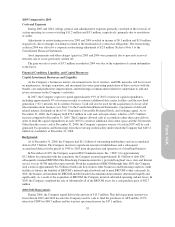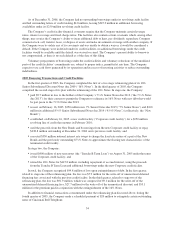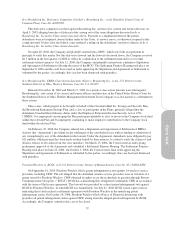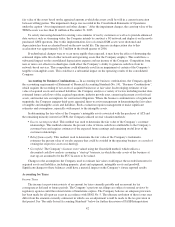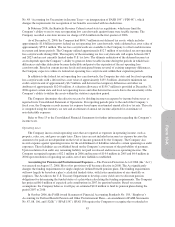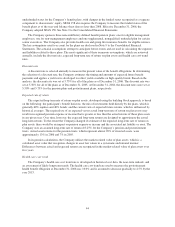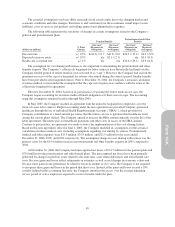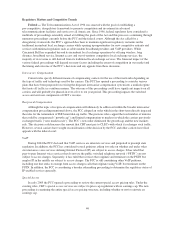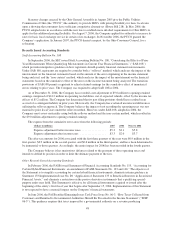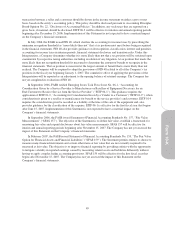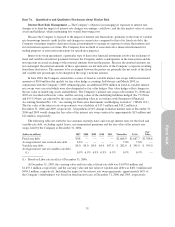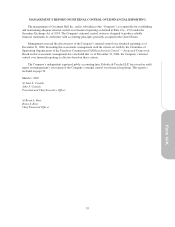Cincinnati Bell 2006 Annual Report Download - page 153
Download and view the complete annual report
Please find page 153 of the 2006 Cincinnati Bell annual report below. You can navigate through the pages in the report by either clicking on the pages listed below, or by using the keyword search tool below to find specific information within the annual report.
No. 48 “Accounting for Uncertainty in Income Taxes—an interpretation of FASB 109” (“FIN 48”), which
changes the requirements for recognition of tax benefits associated with tax deductions.
In February 2006, the Kentucky Revenue Cabinet issued state tax regulations, which may limit the
Company’s ability to use its state net operating loss carryforwards against future state taxable income. The
Company recorded a one-time income tax charge of $3.6 million in the first quarter of 2006.
As of December 31, 2006, the Company had $694.7 million in net deferred tax assets, which includes
approximately $1.6 billion in gross federal tax net operating loss carryforwards, with a deferred tax asset value of
approximately $559.4 million. The tax loss carryforwards are available to the Company to offset taxable income
in current and future periods. The Company utilized approximately $52.7 million of net federal tax net operating
loss carryforwards during 2006. The majority of the remaining tax loss carryforwards will expire between 2017
and 2023 and are not currently limited under U.S. tax laws. The ultimate realization of the deferred income tax
assets depends upon the Company’s ability to generate future taxable income during the periods in which basis
differences and other deductions become deductible and prior to the expiration of the net operating loss
carryforwards. Based on current income levels and anticipated future reversal of existing temporary differences,
the Company expects to utilize its federal net operating loss carryforwards within their expiration periods.
In addition to the federal tax net operating loss carryforwards, the Company has state and local net operating
loss carryforwards with a deferred tax asset value of approximately $155.3 million, alternative minimum tax
credit carryforwards of approximately $6.7 million, and deferred tax temporary differences and other tax
attributes of approximately $124.0 million. A valuation allowance of $150.7 million is provided at December 31,
2006 against certain state and local net operating losses and other deferred tax assets due to the uncertainty of the
Company’s ability to utilize the assets within the statutory expiration period.
The Company determines the effective tax rate by dividing income tax expense by income before taxes as
reported in its Consolidated Statement of Operations. For reporting periods prior to the end of the Company’s
fiscal year, the Company records income tax expense based upon an estimated annual effective tax rate. This rate
is computed using the statutory tax rate and an estimate of annual net income adjusted for an estimate of
non-deductible expenses.
Refer to Note 13 to the Consolidated Financial Statements for further information regarding the Company’s
income taxes.
Operating taxes
The Company incurs certain operating taxes that are reported as expenses in operating income, such as
property, sales, use, and gross receipts taxes. These taxes are not included in income tax expense because the
amounts to be paid are not dependent on the level of income generated by the Company. The Company also
records expense against operating income for the establishment of liabilities related to certain operating tax audit
exposures. These liabilities are established based on the Company’s assessment of the probability of payment.
Upon resolution of an audit, any remaining liability not paid is released and increases operating income. The
Company recognized expense of $2.1 million in 2006 and income of $14.4 million in 2005 and $4.4 million in
2004 upon resolution of operating tax audits, net of new liabilities established.
Accounting for Pension and Postretirement Expenses — The Pension Protection Act of 2006 (the “Act”)
was enacted on August 17, 2006. Most of its provisions will become effective in 2008. The Act significantly
changes the funding requirements for single-employer defined benefit pension plans. The funding requirements
will now largely be based on a plan’s calculated funded status, with faster amortization of any shortfalls or
surpluses. The Act directs the U.S. Treasury Department to develop a new yield curve to discount pension
obligations for determining the funded status of a plan when calculating the funding requirements. The Company
has projected $6.0 million of expected cash contributions in 2007 for pension benefits. Based on current
assumptions, the Company believes it will pay an estimated $110 million to fund its pension plans during the
period 2007 to 2016.
In October 2006, the FASB issued Statement of Financial Accounting Standards No. 158, “Employer’s
Accounting for Defined Benefit Pension and Other Postretirement Plans—an amendment of FASB Statements
No. 87, 88, 106, and 132(R)” (“SFAS 158”). SFAS 158 requires the Company to recognize the overfunded or
43


